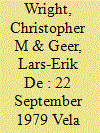| Srl | Item |
| 1 |
ID:
157473


|
|
|
|
|
| Summary/Abstract |
On 22 September 1979 two optical sensors on U.S. satellite Vela 6911 detected a double-flash of light that appeared characteristic of an atmospheric nuclear explosion conducted over the southern Atlantic or Indian Ocean. It became known as the Vela Incident, Event 747, or Alert 747. An anomaly between the amplitude of the two signals during the second pulse led a U.S. government expert panel established to assess the event to conclude in mid-1980 that a more likely explanation was the impact of a small meteoroid on the satellite, the debris from which reflected sunlight into the sensors' field of view. No model was presented to support the contention, and a similar anomaly--known as background modulation--was a given for the second pulse of all confirmed explosions detected by Vela, though beginning later. Nonetheless, this event has remained the subject of intense debate. This article reviews the evidence and presents an updated analysis of the original Vela signal based on recently declassified literature and on modern knowledge of interplanetary dust and hyper velocity impact. Given the geometry of the satellite, and that the bulk of the surface comprised solar panels, much of the debris from any collision would be carried away from the sensors' field of view. Thus, a meteoroid collision appears much less likely than previously assumed. The double flash is instead consistent with a nuclear explosion, albeit detected by an aged satellite for which background modulation was abnormal and/or commenced earlier, also seen in post-event system tests. A companion paper to be published in 2018 presents radionuclide and hydroacoustic evidence supporting the conclusion that the Vela Incident was a nuclear weapon test explosion.
|
|
|
|
|
|
|
|
|
|
|
|
|
|
|
|
| 2 |
ID:
111495


|
|
|
|
|
| Publication |
2012.
|
| Summary/Abstract |
Between 13 and 23 May 2010, four atmospheric radionuclide surveillance stations, in South Korea, Japan, and the Russian Federation, detected xenon and xenon daughter radionuclides in concentrations up to 10 and 0.1 mBq/m3 respectively. All these measurements were made in air masses that had passed over North Korea a few days earlier. This article shows that these radionuclide observations are consistent with a North Korean low-yield nuclear test on 11 May 2010, even though no seismic signals from such a test have been detected. Appendix 1 presents a detailed analysis of the radioxenon data and Appendix 2 describes a hypothetical nuclear test scenario consistent with this analysis, including the possibility that the test used uranium-235 rather than plutonium-239. The analysis suggests that the technical and analytical basis to detect small nuclear tests using radionuclide signatures may be more developed than is generally assumed.
|
|
|
|
|
|
|
|
|
|
|
|
|
|
|
|